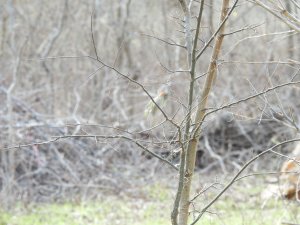Tired
Well-known member

There are a few birds that I've glimpsed at times, but would like to have a better look at. I'm not sure of the best way to find these, aside from going back to the same place at the same time of year.
May last year, I saw a bronzed cowbird with its unwitting foster parent, a starling. I only saw it briefly, but the red eyes and the striking feather ruff made an impression. They look like a bird that a villain in a cartoon would have as a pet. This was at San Gabriel park. I haven't seen one up close since, but think I saw a flock that included some, a month later. I was in the car and sadly couldn't stop.
October last year, I saw some lesser goldfinches along the brush between Blue Hole and San Gabriel park. Any thoughts on where to spot these again? Do I try the same spot?
I saw a female red-winged blackbird, December last year, at Berry Springs. I'd like to see a male. Do I go and check around the reeds and bushes near the water, hope for the best? Do they have particularly nice colors at any time of year?
For several months last year, there were yellow-crowned night herons nesting in my neighborhood. I've never seen them outside that. Would I be able to see these anywhere during the day, or are they strictly nocturnal?
I see caracaras frequently while in the car, as they perch along the side of the road. Is there anywhere I can consistently find some, in order to look at them properly instead of at highway speeds?
I adore kinglets. I've seen a few of them, briefly, at various times of year. I would love to see more. Is there any particular habitat or time that would be best to check?
Lastly: hummingbirds. I see them occasionally, never for very long. They seem to like the Texas red yucca plants in every H-E-B parking lot. My plan for these is to go to Zilker botanical gardens and sit near a likely patch of flowers. What time of year is best for Texas hummingbirds, and how close can I sit without scaring them? They're incredibly fearless- I know multiple people who've had a hummingbird come and inspect a brightly-colored clothing item, and when my mother was young, she had a hummingbird follow her around because of her bright red hair. How far away do I have to be for them to completely ignore me?
May last year, I saw a bronzed cowbird with its unwitting foster parent, a starling. I only saw it briefly, but the red eyes and the striking feather ruff made an impression. They look like a bird that a villain in a cartoon would have as a pet. This was at San Gabriel park. I haven't seen one up close since, but think I saw a flock that included some, a month later. I was in the car and sadly couldn't stop.
October last year, I saw some lesser goldfinches along the brush between Blue Hole and San Gabriel park. Any thoughts on where to spot these again? Do I try the same spot?
I saw a female red-winged blackbird, December last year, at Berry Springs. I'd like to see a male. Do I go and check around the reeds and bushes near the water, hope for the best? Do they have particularly nice colors at any time of year?
For several months last year, there were yellow-crowned night herons nesting in my neighborhood. I've never seen them outside that. Would I be able to see these anywhere during the day, or are they strictly nocturnal?
I see caracaras frequently while in the car, as they perch along the side of the road. Is there anywhere I can consistently find some, in order to look at them properly instead of at highway speeds?
I adore kinglets. I've seen a few of them, briefly, at various times of year. I would love to see more. Is there any particular habitat or time that would be best to check?
Lastly: hummingbirds. I see them occasionally, never for very long. They seem to like the Texas red yucca plants in every H-E-B parking lot. My plan for these is to go to Zilker botanical gardens and sit near a likely patch of flowers. What time of year is best for Texas hummingbirds, and how close can I sit without scaring them? They're incredibly fearless- I know multiple people who've had a hummingbird come and inspect a brightly-colored clothing item, and when my mother was young, she had a hummingbird follow her around because of her bright red hair. How far away do I have to be for them to completely ignore me?




